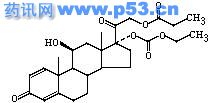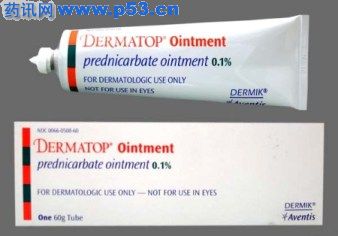|
【中文品名】泼尼卡酯
【药效类别】地塞米松/泼尼松类肾上腺皮质激素
【通用药名】PREDNICARBATE
【别 名】Dermatop,HOE 777,S707777
【化学名称】 Pregna-1,4-diene-3,20-dione, 17-[(ethoxycarbonyl)oxy]-11β-hydroxy-21-(1-oxopropoxy)-
【CA登记号】[73771-04-7]
【结 构 式】

【分 子 式】C27H36O8
【分 子 量】488.59
【收录药典】
【开发单位】Hoechst (德国)
【首次上市】1986年,德国
【性 状】白色结晶。溶于乙醇。mp183℃。
【用 途】
外用甾体抗炎药。有明显的消炎、抗过敏、抗渗出和止痛作用。用于治疗炎症性皮肤病,制剂有软膏,油膏,霜剂。

【原产地英文商品名】DERMATOP 0.1% OINTMENT
【原产地英文药品名】PREDNICARBATE
【中文参考商品译名】DERMATOP 0.1% 软膏
【中文参考药品译名】泼尼卡酯软膏
【生产厂家中文参考译名】赛诺菲-安万特集团
【生产厂家英文名】SANOFI AVENTIS
DRUG DESCRIPTION
DERMATOP® Ointment (prednicarbate ointment) 0.1% contains the non-halogenated prednisolone derivative prednicarbate. The topical corticosteroids constitute a class of primarily synthetic steroids used topically as anti-inflammatory and anti-pruritic agents. Each gram of DERMATOP Ointment 0.1% contains 1.0mg of prednicarbate in a base consisting of white petrolatum, octyldodecanol, glyceryl oleate, propylene glycol, citric acid, and propyl gallate.
------------------------------------------------------------
INDICATIONS
DERMATOP Ointment 0.1% is a medium potency corticosteroid indicated for the relief of the inflammatory and pruritic manifestations of corticosteroid responsive dermatoses.
------------------------------------------------------------
DOSAGE AND ADMINISTRATION
Apply a thin film of DERMATOP Ointment 0.1% to the affected skin areas twice daily. Rub in gently.
------------------------------------------------------------
SIDE EFFECTS
In controlled clinical studies, the incidence of adverse reactions associated with the use of DERMATOP Ointment 0.1% was approximately 1.5%. Reported reactions including burning, pruritis, drying, scaling, cracking and pain and irritant dermatitis. The following additional local adverse reactions are reported infrequently with topical corticosteroids, but may occur more frequently with the use of occlusive dressings and especially with higher potency corticosteroids. These reactions are listed in an approximate decreasing order of occurrence: folliculitis, hypertrichosis, acneiform eruptions, hypopigmentation, perioral dermatitis, allergic contact dermatitis, secondary infection, skin atrophy, striae and miliaria.
------------------------------------------------------------
PRECAUTIONS
General
Systemic absorption of topical corticosteroids can produce reversible hypothalamic-pituitary-adrenal (HPA) axis suppression with the potential for glucocorticosteroid insufficiency after withdrawal of treatment. Manifestations of Cushing's syndrome, hyperglycemia, and glucosuria can also be produced in some patients by systemic absorption of topical corticosteroids while on treatment. Patients receiving a large dose of a higher potency topical steroid applied to a large surface area or under occlusion should be evaluated periodically for evidence of HPA-axis suppression. This may be done by using the ACTH stimulation, A.M. plasma cortisol, and urinary free cortisol tests.
DERMATOP Ointment 0.1% did not produce significant HPA-axis suppression when used at a dose of 60 grams per day for a week in patients with exten- sive psoriasis or atopic dermatitis.
However, if HPA-axis suppression is noted, an attempt should be made to withdraw the drug, to reduce the frequency of application, or to substitute a less potent corticosteroid. Recovery of HPA-axis function is generally prompt and complete upon discontinuation of topical corticosteroids. Infrequently, signs and symptoms of glucocorticosteroid insufficiency may occur requiring supplemental systemic corticosteroids. For information on systemic supplementation, see prescribing information for those products.
Pediatric patients may be more susceptible to systemic toxicity from equivalent doses due to their larger skin surface to body mass ratios. (See PRECAUTIONS-Pediatric Use.)
If irritation develops, DERMATOP Ointment 0.1% should be discontinued and appropriate therapy instituted. Allergic contact dermatitis with corticosteroids is usually diagnosed by observing failure to heal rather than noting a clinical exacerbation as with most topical products not containing corticosteroids. Such an observation should be corroborated with appropriate diagnostic patch testing.
If concomitant skin infections are present or develop, an appropriate antifungal or antibacterial agent should be used. If a favorable response does not occur promptly, use of DERMATOP Ointment (prednicarbate ointment) 0.1% should be discontinued until the infection has been adequately controlled.
Carcinogenesis, Mutagenesis, and Impairment of Fertility
In a study of the effect of prednicarbate on fertility, pregnancy and postnatal development in rats, no effect was noted on the fertility or pregnancy of the parent animals or postnatal development of the offspring after administration of up to 0.80 mg/kg of prednicarbate subcutaneously.
Prednicarbate has been evaluated in the Salmonella reversion test (Ames test) over a wide range of concentrations in the presence and absence of an S-9 liver microsomal fraction and did not demonstrate mutagenic activity. Similarly, prednicarbate did not produce any significant changes in the numbers of micronuclei seen in erythrocytes when mice were given doses ranging from 1 to 160 mg/kgof the drug.
Pregnancy
Teratogenic effects: Pregnancy Category C. Corticosteroids have been shown to be teratogenic in laboratory animals when administered systemically at relatively low dosage levels. Some corticosteroids have been shown to be teratogenic after dermal application in laboratory animals.
Prednicarbate has been shown to be teratogenic and embryotoxic in Wistar rats and Himalayan rabbits when given subcutaneously during gestation at doses 1900times and 45times, respectively, the recommended topical human dose, assuming a percutaneous absorption of approximately 3%.
In the rats, slightly retarded fetal development and an incidence of thickened and wavy ribs which was higher than the spontaneous rate were noted.
In rabbits, there was noted increased liver weights and slight increase in the fetal intrauterine death rate. The fetuses delivered exhibited reduced placental weight, increased frequency of cleft palate, ossification disorders in the sternum, omphalocele, and anomalous posture of the forelimbs.
There are no adequate and well-controlled studies in pregnant women on teratogenic effects of prednicarbate. Therefore, DERMATOP Ointment (prednicarbate ointment) 0.1% should be used during pregnancy only if the potential benefit justifies the potential risk to the fetus.
Nursing Mothers
Systemically administered corticosteroids appear in human milk and could suppress growth, interfere with endogenous corticosteroid production, or cause other untoward effects. It is not known whether topical administration of corticosteroids could result in sufficient systemic absorption to produce detectable quantities in human milk. Because many drugs are excreted in human milk, caution should be exercised when DERMATOP Ointment (prednicarbate ointment) 0.1% is administered to a nursing woman.
Pediatric Use
Safety and effectiveness of DERMATOP Ointment 0.1% in pediatric patients below the age of 10 years have not been established. Because of a higher ratio of skin surface area to body mass, pediatric patients are at a greater risk than adults of HPA axis suppression when they are treated with topical corticosteroids. They are therefore also at greater risk of glucocorticosteroid insufficiency after withdrawal of treatment and of Cushing's syndrome while on treatment. Adverse effects including striae have been reported with inappropriate use of topical corticosteroids in pediatric patients. (See PRECAUTIONS.) HPA-axis suppression, Cushing's syndrome, and intracranial hypertension have been reported in pediatric patients receiving topical corticosteroids. Manifestations of adrenal suppression in pediatric patients include linear growth retardation, delayed weight gain, low plasma cortisol levels, and absence of response to ACTH stimulation. Manifesta- tions of intracranial hypertension include bulging fontanelles, headaches, and bilateral papilledema.
------------------------------------------------------------
PATIENT INFORMATION
Patients using topical corticosteroids should receive the following information and instructions:
1、This medication is to be used as directed by the physician. It is for external use only. Avoid contact with the eyes.
2、This medication should not be used for any disorder other than that for which it was prescribed.
3、The treated skin area should not be bandaged or otherwise covered or wrapped so as to be occlusive, unless directed by the physician.
4、Patients should report to their physician any signs of local adverse reactions | 



